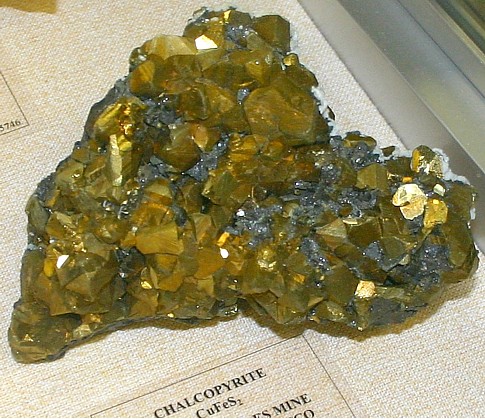|
.
Chalcopyrite Mineral Facts:
Chemical
Formula: CuFeS2
ie., Copper Pyrites, Yellow
Copper Ore.
Colors:
Brass yellowish, sometimes
surfaces are tarnished to iridescent.
Its streak is greenish black.
Hardness:
3.5 to 4
Density: 4.2
For Both the density and hardness
reading for aragonite are higher than normally found for calcite.
Cleavage:
No cleavage,
fracture is
uneven;
brittle.
Crystallography:
Tetragonal
It occurs both massive and crystallized. From its similarity to pyrite
in appearance it is often known as copper pyrites. The mineral often
contains small quantities of intermixed pyrite, It also contains in some
instances selenium, thallium, gold and silver.
Luster:.
Metallic luster.
It is an
excellent conductor of electricity.
Optics:
(Refractive Index) a = 1.53; b = 1.68; y = 1.685
|
 |
Composition,
Structure and Associated Minerals:
When
subjected to the action of the atmosphere or to percolating atmospheric
water chalcopyrite loses its iron component and changes to covellite and
chalcocite, producing an iridescent surface. The iron passes into limonite.
Bornite,copper and pyrite are also frequent products of its alteration. In
the oxidation zone of veins it yields
limonite, the carbonates,
malachite
and
azurite, and
cuprite (Cu2O). When exposed to the leaching action of
water, limonite alone may remain to mark the outcrop of veins, the copper
being carried downward in solution to enrich the lower portions of the vein.
The deposit of limonite on the surface is known as gossan.
Known
sometimes as "fool's gold'' a term which is also applied at times to
pyrite.
It also impregnates slates and other
sedimentary rocks, schists and altered igneous rocks where, in some cases,
it is a contact deposit and in others is original. It is also formed by
secondary processes causing enrichment of copper
sulfide veins. Its most
common associates are galena, sphalerite and pyrite.
Identification and Diagnostics
After roasting, and
moistening with hydrochloric acid, gives an azure-blue flame. Readily
decomposed by nitric acid, giving separated sulphur; solution made
ammoniacal gives red / brown precipitate of ferric hydroxide and blue
filtrate (copper). Recognized by its brass-yellow color, greenish black
streak and its softness. Distinguished from pyrite by its being softer than
steel and from gold by its being brittle.
Occurrence,
Localities and Origins:
The most common ore
of copper. Occurs widely distributed in metallic veins associated with
pyrite, pyrrhotite, bornite, chalcocite, tetrahedrite, malachite, azurite,
sphalerite,
galena,
quartz,
calcite,
dolomite, siderite, etc. May carry
gold
or
silver ore and become an ore of those metals. Often in subordinate amount
with large bodies of pyrite, making them serve as low-grade
copper ores.
Chief ore of copper mines at Cornwall, England; Falun, Sweden; Rio Tinto,
Spain; Sudbury, Canada. It is also the important copper ore of the deposits
of Falun, Sweden, of Namaqualand in South Africa, those near Copiapo in
Chile, those of Mansfeld, Germany. Found widely in the United States but
usually in connection with other copper minerals in equal or greater amount;
found at Butte, Montana; Bingham, Utah; various districts in California,
Colorado, Arizona, Nevada, etc. The name is derived from Greek word meaning
brass and from pyrites.
Uses:
Chalcopyrite is
the most important primary ore of copper.
A
large portion of the
copper produced in the world is obtained by the smelting of chalcopyrite and
the ores associated with it.
Return to the
Mineral Collectors Information Page |
|


